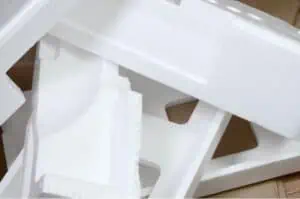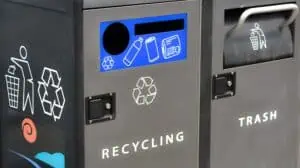Sustainable business practices have become increasingly important as companies strive to minimize their environmental impact. One material that is prevalent in many businesses is polystyrene, commonly known as Styrofoam.
This article will explore the potential for polystyrene recycling, its environmental implications, and advancements in recycling technologies. Additionally, we will delve into an innovative recycling process utilized by Generated Materials Recovery (GMR) that offers businesses an efficient and convenient way to recycle polystyrene waste.
Understanding Polystyrene
Polystyrene is a widely used plastic material that offers numerous advantages in various industries. Its popularity stems from its lightweight nature, versatility, and desirable properties. Polystyrene is known for its excellent insulation capabilities, which make it an ideal choice for applications where thermal protection is essential. This insulation property helps maintain the temperature of products during transportation and storage.
Durability is another key characteristic of polystyrene. It is a robust material that can withstand impacts and provide adequate protection to fragile items. This durability makes it a preferred choice for packaging sensitive products such as electronics, appliances, and medical supplies. Polystyrene’s ability to cushion and absorb shocks reduces the risk of damage during transit.
This material is also cost-effective compared to other alternatives, making it a practical choice for businesses operating on tight budgets, allowing businesses to meet their packaging needs without compromising on quality or functionality.
Polystyrene is available in two main forms:
- expanded polystyrene (EPS) and
- non-expanded polystyrene.
Expanded polystyrene is created by expanding small polystyrene beads using steam and a blowing agent, resulting in a lightweight foam material with a closed-cell structure. This form of polystyrene is commonly used for protective packaging, insulation panels, and construction materials. Its low density and excellent insulation properties make it an effective choice for minimizing heat transfer and protecting fragile items during shipping.
Non-expanded polystyrene, on the other hand, is a solid and rigid form of the material. It is commonly used in disposable food containers, cups, and utensils due to its insulating properties and ability to maintain the temperature of hot and cold beverages or food items. Non-expanded polystyrene offers convenience, hygiene, and cost-effectiveness for food service applications.
Can You Recycle Polystyrene?
Polystyrene recycling faces challenges due to limited recycling infrastructure. However, it is important to note that polystyrene can be recycled, and recycling it is crucial to mitigate its environmental impact. Improper disposal of polystyrene waste, such as dumping it in landfills or incineration, can lead to pollution and contribute to the depletion of natural resources.
Recycling polystyrene also makes good economic sense. By implementing recycling programs, businesses can potentially reduce waste management costs and even generate revenue through the mitigation of complex waste management.
Advances in Polystyrene Recycling
There have been significant advancements in polystyrene recycling technologies in recent years. Two notable methods are pyrolysis and gasification. Pyrolysis involves heating polystyrene waste in the absence of oxygen to break it down into useful chemicals and fuels. Gasification, on the other hand, uses high temperatures to convert polystyrene waste into a synthetic gas that can be used for energy production or as a raw material for other processes.
Biological degradation methods are also being explored, where microorganisms are employed to break down polystyrene waste into biodegradable components. These emerging technologies show promise in providing more sustainable and efficient alternatives for polystyrene recycling.
However, it is important to consider the potential benefits and drawbacks of these new recycling methods, including scalability, energy requirements, and environmental impact. They are also incredibly challenging for businesses to accomplish on their own.
The Generated Materials Recovery (GMR) Process
One innovative recycling process that aims to address the challenges of polystyrene recycling is that offered by Generated Materials Recovery (GMR). GMR offers businesses an efficient and convenient way to recycle their polystyrene waste. GMR provides recycling solutions that work according to the businesses’ schedule, minimizing disruptions to their operations.
The GMR process involves collecting all waste materials, including polystyrene, from businesses and converting them into useful, recyclable materials. The collected waste is processed and transformed into a clean, densified material that can be used in various manufacturing applications. By participating in GMR, businesses can contribute to the circular economy and reduce their environmental footprint.
Get started with Generated Materials Recovery today.
Polystyrene recycling presents both environmental and economic benefits. While the infrastructure for polystyrene recycling is still limited, advancements in recycling technologies offer hope for a more sustainable future. The emerging methods of pyrolysis, gasification, and biological degradation show promise in efficiently recycling polystyrene waste.
The methods used by Generated Materials Recovery provide businesses with a convenient and effective way to recycle polystyrene. GMR allows businesses to prioritize sustainable practices and embrace recycling initiatives. Businesses can play a significant role in reducing the environmental impact of polystyrene and contribute to a greener future.







